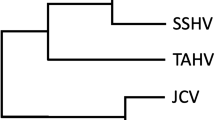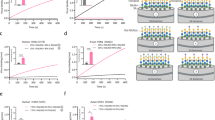Abstract
INFLUENZA A viruses of human and avian origin have a common (type-specific), ribonucleoprotein antigen which is located in the virus particle. Haemagglutination-inhibition (HI) tests and strain specific complement-fixation (CF) tests on some eighty avian influenza strains studied at the World Influenza Centre, London1–3, indicated a wide range of antigenic variation in the antigens of their outer envelopes (subtype-specific antigens). Limited attempts to demonstrate antigenic similarities in the surface antigens of avian and human influenza viruses using similar tests produced negative results, with the exception of cross-reactions demonstrated between A2/Singapore/1/57 and A/turkey/Massachusetts/65 (refs. 4 and 5). Closer studies on the antigenic structure of these latter agents using neuraminidase-inhibition (NI) and immunoprecipitation tests6,7 indicated that A/turkey/Massachusetts/65 virus contained a neuraminidase which was antigenically identical to that of the human A2 virus strain, whereas its haemagglutinin was unrelated to that of human influenza viruses. NI tests, immunoprecipitation tests as well as HI tests have thus been used in the study of avian influenza A viruses sent to this laboratory for identification. We describe here studies on a virus isolated from ducks in 1968 which indicated close antigenic similarities between its neuraminidase and that of human A0 and A1 virus strains.
This is a preview of subscription content, access via your institution
Access options
Subscribe to this journal
Receive 51 print issues and online access
$199.00 per year
only $3.90 per issue
Buy this article
- Purchase on Springer Link
- Instant access to full article PDF
Prices may be subject to local taxes which are calculated during checkout
Similar content being viewed by others
References
Pereira, H. G., Tumova, B., and Law, V. G., Bull. WHO, 32, 855 (1964).
Pereira, H. G., Lang, G., Olesiuk, O. M., Dudeyenbos, G. M., Roberts, D. H., and Easterday, B. C., Bull. WHO, 35, 799 (1966).
Pereira, H. G., Rinaldi, A., and Nardelli, L., Bull. WHO, 37, 553 (1967).
Tumova, B., and Pereira, H. G., Bull. WHO, 38, 415 (1968).
Pereira, H. G., Tumova, B., and Webster, R. G., Nature, 215, 982 (1967).
Webster, R. G., and Pereira, H. G., J. Gen. Virol., 3, 201 (1968).
Schild, G. C., and Pereira, H. G., J. Gen. Virol., 4, 355 (1969).
Schettler, C. H., Wld. Vet. Poult. Ass. (Congress, 1969).
Laver, W. G., and Kilbourne, E. D., Virology, 30, 493 (1966).
Easterday, B., Laver, W. G., Pereira, H. G., and Schild, G. C., J. Gen. Virol. (in tbe press).
Laver, W. G., J. Mol. Biol., 9, 109 (1964).
Paniker, C. K. J., J. Gen. Virol., 2, 385 (1968).
Pereira, M. S., Pereira, H. G., and Law, V. G., Bull. WHO, 31, 129 (1964).
Lief, F. S., and Henle, W., Bull. WHO, 20, 411 (1959).
WHO Tech. Rep. Ser., 64, 32 (1953).
Tumova, B., and Pereira, H. G., Virology, 27, 253 (1965).
Author information
Authors and Affiliations
Rights and permissions
About this article
Cite this article
SCHILD, G., PEREIRA, H. & SCHETTLER, C. Neuraminidase in Avian Influenza A Virus antigenically related to that of Human A0 and A1 Subtypes. Nature 222, 1299–1301 (1969). https://doi.org/10.1038/2221299a0
Received:
Issue Date:
DOI: https://doi.org/10.1038/2221299a0
This article is cited by
-
Influenza A viruses: Combinations of hemagglutinin and neuraminidase subtypes isolated from animals and other sources
Archives of Virology (1981)
-
A re-examination of the single radial haemolysis technique for the assay of influenza anti-neuraminidase antibodies in human sera
Archives of Virology (1980)
-
Influenza A viruses: Combinations of hemagglutinin and neuraminidase subtypes isolated from animals and other sources
Archives of Virology (1979)
-
Antibodies to type A influenza viruses in sera from nonhuman primates
Archiv f�r die gesamte Virusforschung (1973)
-
Vergleichende Untersuchungen an Proteinen von Influenzaviren
Experientia (1971)
Comments
By submitting a comment you agree to abide by our Terms and Community Guidelines. If you find something abusive or that does not comply with our terms or guidelines please flag it as inappropriate.



